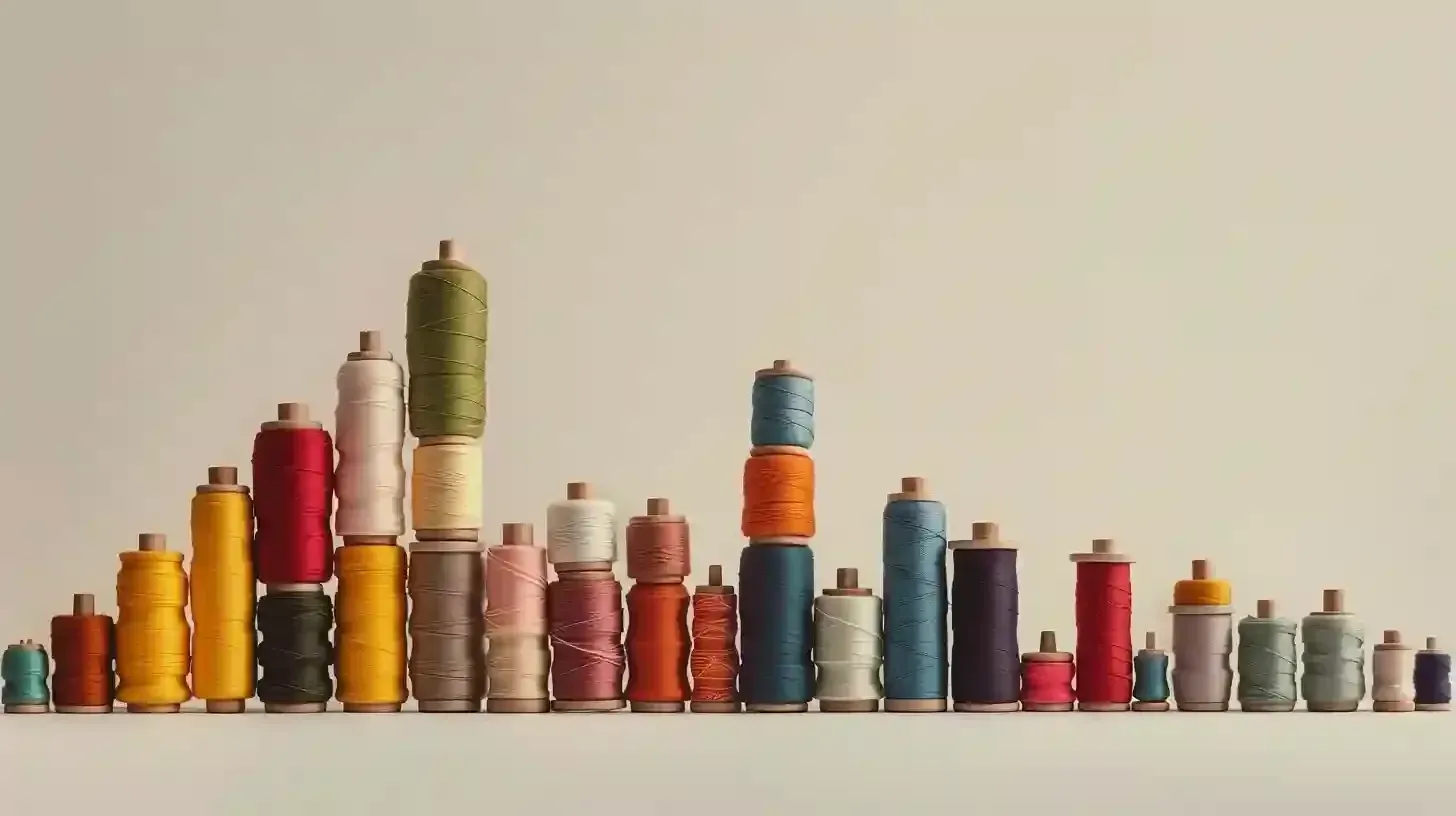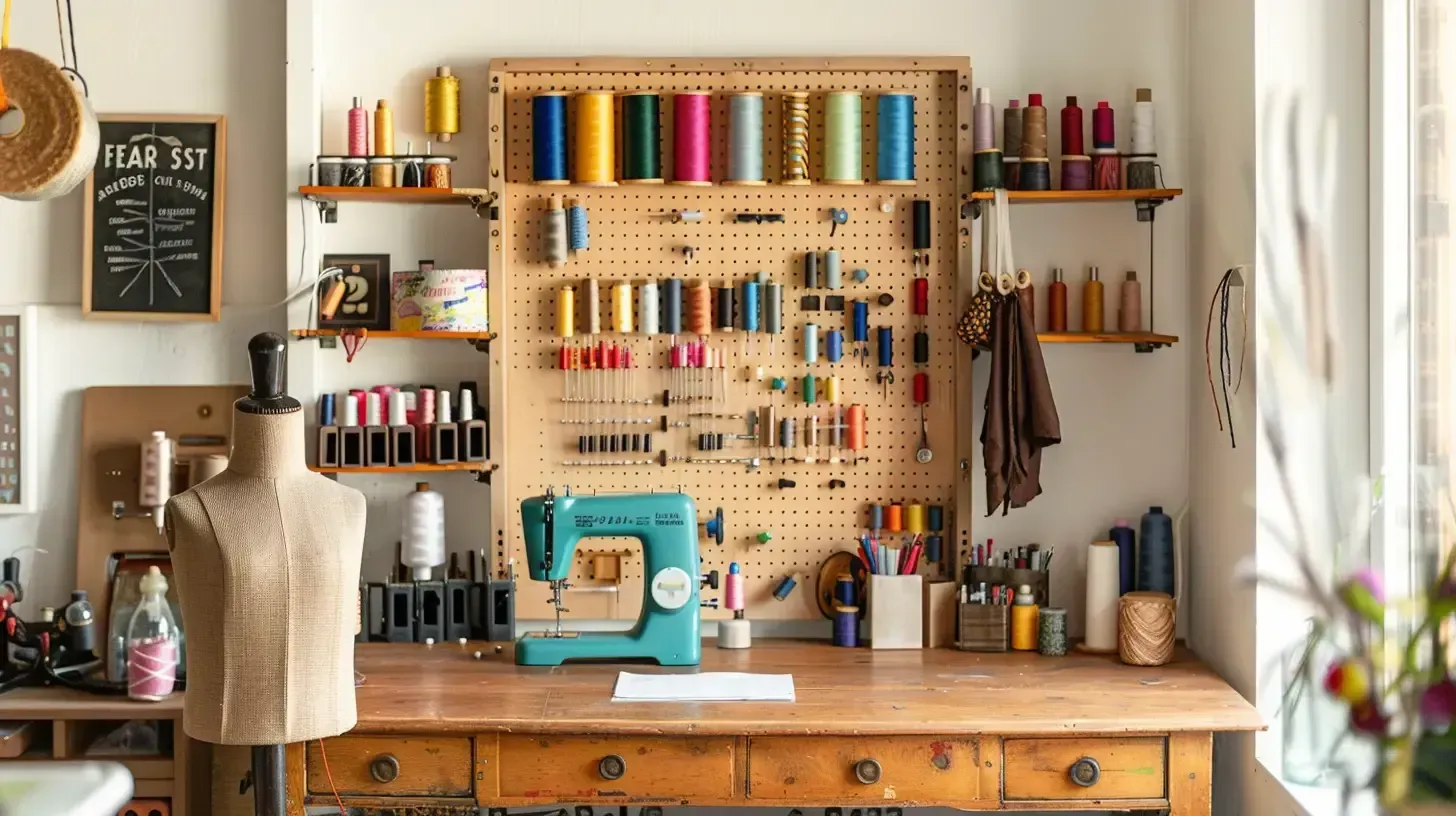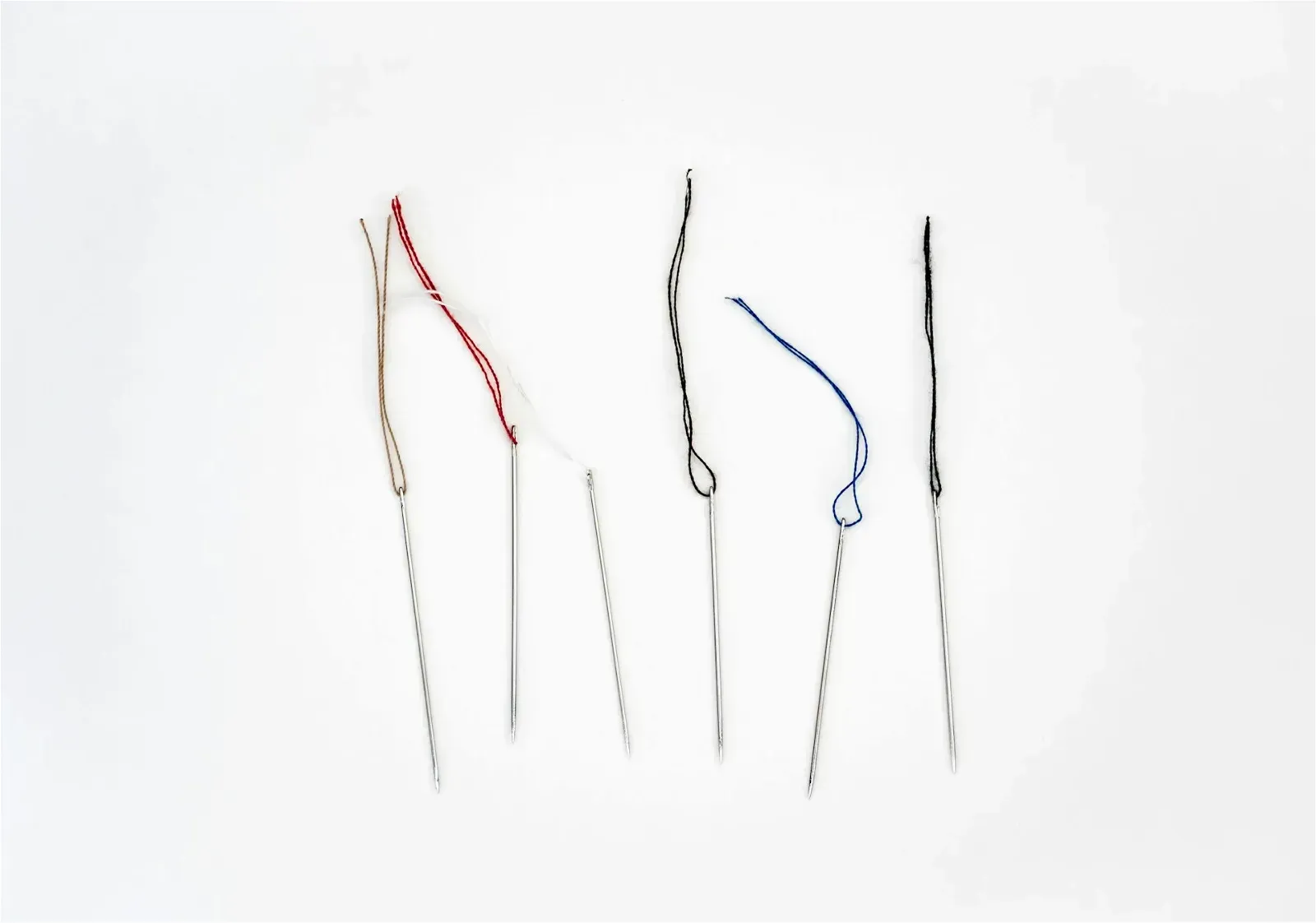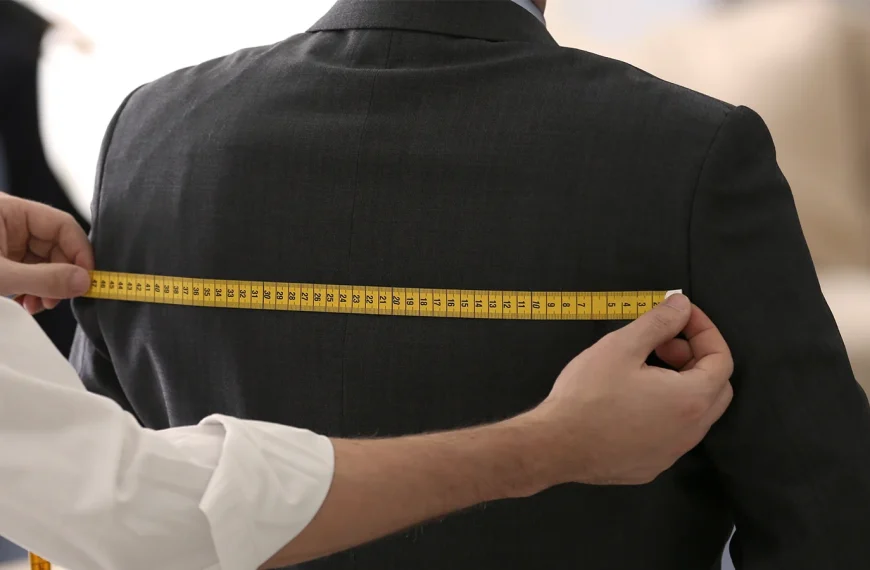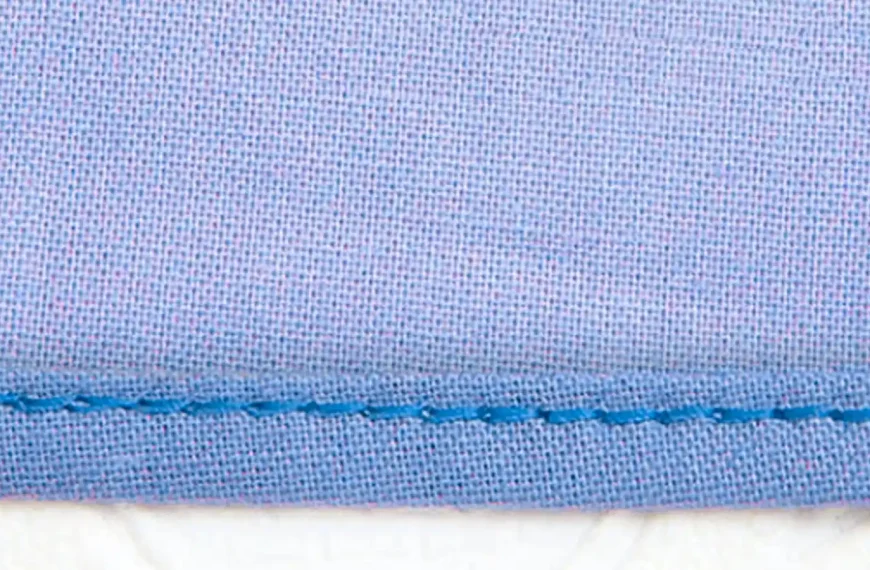Did you know that 60% of the success of your sewing project hinges on the right selection of thread size?
The sewing thread size chart is useful for both professionals and amateur sewers. Make sure to familiarize yourself with different measuring methods before selecting threads. This guide explains how thread size and fabric type affect the quality of your stitches. So, why not take a closer look at this chart? It may seem like a simple piece of information, but its impact on your sewing projects could be enormous.
Key Takeaways
-
There are various thread size standards such as weight, denier, Tex, and commercial sizes.
-
Thread fiber types include polyester, cotton, rayon, nylon, and silk, each with unique characteristics and uses.
-
Commercial thread sizes, represented by ‘V’, provide an additional gauge for thread selection, with larger numbers indicating heavier threads.
-
To choose the right thread, check the label and make sure the thread size matches the weight of the fabric. Adjust the thread tension and test the stitching.
Classification of Common Sewing Thread Size

Knowing the different sizes of sewing threads can greatly impact your sewing projects as you work on them. Threads are categorized by different standards. There are three main standards for measuring thread thickness and use: weight, denier, and Tex. Don’t forget about commercial sizes (V) as they can also help you choose the right thread for the job.
Weight Standard
Understanding thread sizes is important for choosing the right thread for your sewing project. Thread size is determined by weight, with lower weight numbers indicating thicker, more visible threads. A thread labeled as 30 wt is heavier than a thread labeled as 50 wt. This is because it takes only 30 kilometers of the 30 wt thread to reach 1 kilogram, while it takes 50 kilometers of the 50 wt thread to reach the same weight. That is to say, the thread with thicker, heavier weight is a lower number. But this standard is only used in the US and it is not accurate.
Denier Standard
The denier standard is commonly used to classify sewing thread size, especially for nylon fabrics and heavy-duty threads. The denier system measures thread weight based on 9000 meters, making it ideal for determining both thread thickness and durability. The larger the number means the heavier the thread.
Here are 4 crucial aspects to keep in mind about the denier standard:
-
It’s particularly suitable for heavy-duty threads, like those used in upholstery and industrial sewing.
-
Denier numbers indicate the weight. The lower the number means the lighter the thread. The thread with a weight of 225 deniers is the most common thread.
-
Understanding denier measurements can assist in selecting the right thread.
-
This method ensures the durability of your sewing project.
Tex Standard
The Tex standard is a reliable method for measuring the size of sewing thread. It focuses on the weight per 1000 meters of thread. A thread weighing 25 grams and measuring 1000 meters is classified as Tex 25. Remember, the higher the Tex, the thicker the thread. This allows for a consistent measure of thread thickness. This unit is accepted by the International Organization for Standardization.
A prime example is Tex 70, the heaviest commercial size suitable for home sewing machines. This weight offers increased stitching visibility, but it may require adjustments to your sewing machine tension.
Understanding the Tex standard is essential for selecting the appropriate thread weight for different sewing projects. The Tex system is commonly used for polyester and nylon threads.
This knowledge ensures a successful outcome for your sewing endeavors.
Commercial Sizes (V)
To understand sewing thread size, it is important to learn about the commercial sizes (V) system, an additional classification. This classification aids in selecting the right thread for your sewing projects.
Here are some key points to remember:
-
Commercial sizes (V) classify thread thickness; larger numbers mean heavier threads.
-
Common sizes for domestic machines range from V-30 to V-70.
-
For instance, V-92 represents a Tex 90 thread, while V-69 denotes a Tex 70 thread.
-
This standardized system helps in choosing the appropriate thread weight, ensuring your sewing project’s success.
Mastering the thread game requires a deep understanding of commercial sizes.
Composition of Thread Fibers

In your sewing journey, knowing the composition of thread fibers is crucial. Threads come in different types such as polyester, cotton, rayon, nylon, and silk, each having its own unique qualities. Use different threads for different projects.
There are many different threads. Understanding the differences between these fibers can guide you in selecting the right thread for your project.
Polyester
Polyester threads have great UV resistance, which makes them ideal for outdoor use. Polyester, being a cost-effective outdoor thread, is lauded for its durability and UV resistance. It is widely used in industrial machines.
Here are some key points:
-
Polyester threads have superior UV resistance, making them perfect for outdoor use.
-
Most home sewing machines can comfortably handle polyester threads up to Tex 70, offering versatility for your stitching needs.
-
Polyester is a cost-effective choice, as it generally costs less than nylon. It is also used in industrial projects.
Cotton
Cotton thread is a great option for sewing, especially if you prefer natural fibers over synthetic materials like polyester. This is an all-purpose thread. Cotton thread is soft, breathable, and blends well with natural fabrics. This characteristic sets it apart from its polyester counterpart. Cotton thread is usually used in home sewing machines.
Its composition makes it a versatile choice for your sewing machine. Cotton threads are ideal for quilting and other general sewing projects. You’ll find cotton thread in various weights such as 28, 40, 50, and 60, offering you flexibility for different applications.
You can use a sewing thread size chart to help you choose the right cotton thread for your projects, leading to successful results.
Rayon
Rayon thread is a good choice for adding shine and strength to sewing projects. It is one of the best sewing machine threads. It is a filament made from regenerated cellulose fibers. Here’s the reason:
-
Radiant shine: Rayon thread showcases a brilliant and glossy shine. It is a glossy touch to your embroidery and quilting projects.
-
Color diversity: Rayon thread comes in a wide array of colors, perfect for intricate designs.
-
Durability: Not only is rayon thread durable, it also holds its color well. Your projects will stand the test of time.
-
Soft and lightweight: If you’re working with delicate fabrics, rayon thread is ideal. It’s softer than polyester and has a natural feel similar to cotton.
Choose Rayon thread for a stunning, long-lasting finish.
Nylon
Nylon thread is a great choice for heavyweight fabric because it is made from synthetic polymers. The sewing thread size chart shows that nylon thread is available in different sizes, ranging from light to heavy. This provides you with many options for your projects.
Here’s a simple table to help you understand:
|
Thread Size |
Common Uses |
Suitable for Home Machines |
|
Lightweight |
Delicate fabrics |
Yes |
|
Medium Weight |
General sewing |
Yes |
|
Heavyweight |
Canvas, leather |
Limited |
The vast majority of household sewing machines can effectively accommodate nylon thread up to size 69. So, whether you’re stitching delicate fabric or a sturdy canvas, there’s a bonded nylon suitable for your needs. Remember, the right thread size contributes significantly to the success of your sewing project.
Silk
Consider silk threads when searching for the ideal thread. They are made from the protein fibers of silkworms. These threads are famous for being shiny and strong, so they are often chosen for delicate sewing projects. It is usually used for embroidery threads. Yet, while silk thread adds a touch of luxury, it also demands special care.
To fully appreciate silk threads, consider these four key points:
-
It offers a smooth, glossy finish that enhances the overall look of your sewing project.
-
Despite its delicate nature, silk has high tensile strength, ensuring the durability of your stitches.
-
It is ideal for intricate embroidery and decorative stitching.
-
Due to its delicate nature, silk thread requires careful handling to prevent breakage.
Wool
The characteristic of wool thread is different from silk. Made from the natural fibers of sheep, wool thread is a remarkable material that offers unparalleled quality. So it is great for many sewing projects. Renowned for its warmth and softness, this thread comes in a range of weights and colors, appealing to diverse crafting needs.
Take note of the ply, a crucial element of wool yarn. This means two fibers twist together to create the thread. It significantly impacts both its strength and thickness. The weight of wool thread, another key factor, corresponds to its thickness, impacting your project’s final look. Its resilience is impressive, with an ability to retain shape and provide durable stitches. Moreover, wool thread is eco-friendly and biodegradable, adding a sustainable touch to your work.
Guide on How to Choose Sewing Thread Size

There are an amount of threads to choose, so pick the most suitable one for your sewing projects. Use the right thread size for the fabric weight to make strong and durable seams in your sewing projects. This also ensures that the thread tension is maintained, preventing uneven stitches or breakage. Understanding thread labels helps make this matching process easier.
-
Thread labels provide valuable information about thread weight and size.
-
When working with different fabrics, it is important to match the thread size to the weight of the material. This simple adjustment will guarantee high-quality seams that will withstand the test of time.
-
Please ensure that you pay attention to the thread tension. Heavier threads need lower tension settings, while thinner threads require higher tension.
-
Before sewing, always test the stitch on a scrap piece of fabric to make sure the thread size and tension are correct.
Follow these steps, and you’ll avoid the common pitfalls of mismatched thread and fabric.
Conclusion
You’re now equipped to choose the perfect thread size and composition for your projects. Remember, choosing the correct thread and needle is pivotal for hand and machine sewing. Take caution to make the final choice. Happy stitching!
Learn more sewing tips on Longan Craft Blog! Dive into the fabric world with Longancraft!

